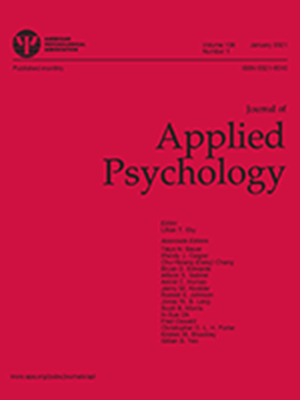On the efficacy of psychological separation to address common method variance: Experimental evidence and a guiding research design framework.
IF 6.1
1区 心理学
Q1 MANAGEMENT
引用次数: 0
Abstract
Common method variance (CMV) substantially impacts how scholars conduct and review research. Several procedural and statistical remedies have been proposed to address the potential biasing effects that can result from CMV in data procured from a single source on a single occasion. Among them, temporal separation and distinct source designs have been the most popular. Psychological separation (PS) has also been proposed as a way to address CMV, by diverting respondents' attention from previously accessed memories, disrupting response consistency patterns, and improving effortful responding. The present research attempted to create efficacious PS through a cognitive interference task administered midway through a survey, thereby attenuating correlations that could be affected by CMV to varying degrees. In an initial study and a constructive replication, our results show that a PS intervention of at least 7.5-min attenuated several relationships to levels significantly lower than those in a single source on a single occasion design, but to an extent consistent with the attenuation achieved by temporal separation or distinct source designs. These findings suggest that under appropriate circumstances, PS is an effective strategy to address certain forms of CMV. We conclude by providing a decision guide for responsibly choosing a research design in light of various theoretical, methodological, and logistical considerations, as well as offering several additional PS task examples that can be deployed in future studies. (PsycInfo Database Record (c) 2025 APA, all rights reserved).论心理分离对解决常见方法差异的有效性:实验证据与指导性研究设计框架。
通用方法方差(Common method variance, CMV)对学者进行研究和评价的方式有很大的影响。已经提出了一些程序和统计补救措施来解决CMV在单一场合从单一来源获得的数据中可能导致的潜在偏倚效应。其中,时间分离和不同源设计最为流行。心理分离(PS)也被提出作为解决CMV的一种方法,通过转移受访者对先前访问记忆的注意力,破坏反应一致性模式,并改善努力反应。本研究试图通过在调查过程中执行认知干扰任务来创建有效的PS,从而在不同程度上减弱CMV可能影响的相关性。在初步研究和建设性的复制中,我们的结果表明,至少7.5分钟的PS干预将几种关系衰减到明显低于单一场合设计中单一源的水平,但在一定程度上与时间分离或不同源设计所实现的衰减一致。这些发现表明,在适当的情况下,PS是一种有效的策略,以解决某些形式的巨细胞病毒。最后,我们提供了一个决策指南,根据各种理论、方法和后勤考虑,负责任地选择研究设计,并提供了几个额外的PS任务示例,可以在未来的研究中部署。(PsycInfo Database Record (c) 2025 APA,版权所有)。
本文章由计算机程序翻译,如有差异,请以英文原文为准。
求助全文
约1分钟内获得全文
求助全文
来源期刊

Journal of Applied Psychology
Multiple-
CiteScore
17.60
自引率
6.10%
发文量
175
期刊介绍:
The Journal of Applied Psychology® focuses on publishing original investigations that contribute new knowledge and understanding to fields of applied psychology (excluding clinical and applied experimental or human factors, which are better suited for other APA journals). The journal primarily considers empirical and theoretical investigations that enhance understanding of cognitive, motivational, affective, and behavioral psychological phenomena in work and organizational settings. These phenomena can occur at individual, group, organizational, or cultural levels, and in various work settings such as business, education, training, health, service, government, or military institutions. The journal welcomes submissions from both public and private sector organizations, for-profit or nonprofit. It publishes several types of articles, including:
1.Rigorously conducted empirical investigations that expand conceptual understanding (original investigations or meta-analyses).
2.Theory development articles and integrative conceptual reviews that synthesize literature and generate new theories on psychological phenomena to stimulate novel research.
3.Rigorously conducted qualitative research on phenomena that are challenging to capture with quantitative methods or require inductive theory building.
 求助内容:
求助内容: 应助结果提醒方式:
应助结果提醒方式:


